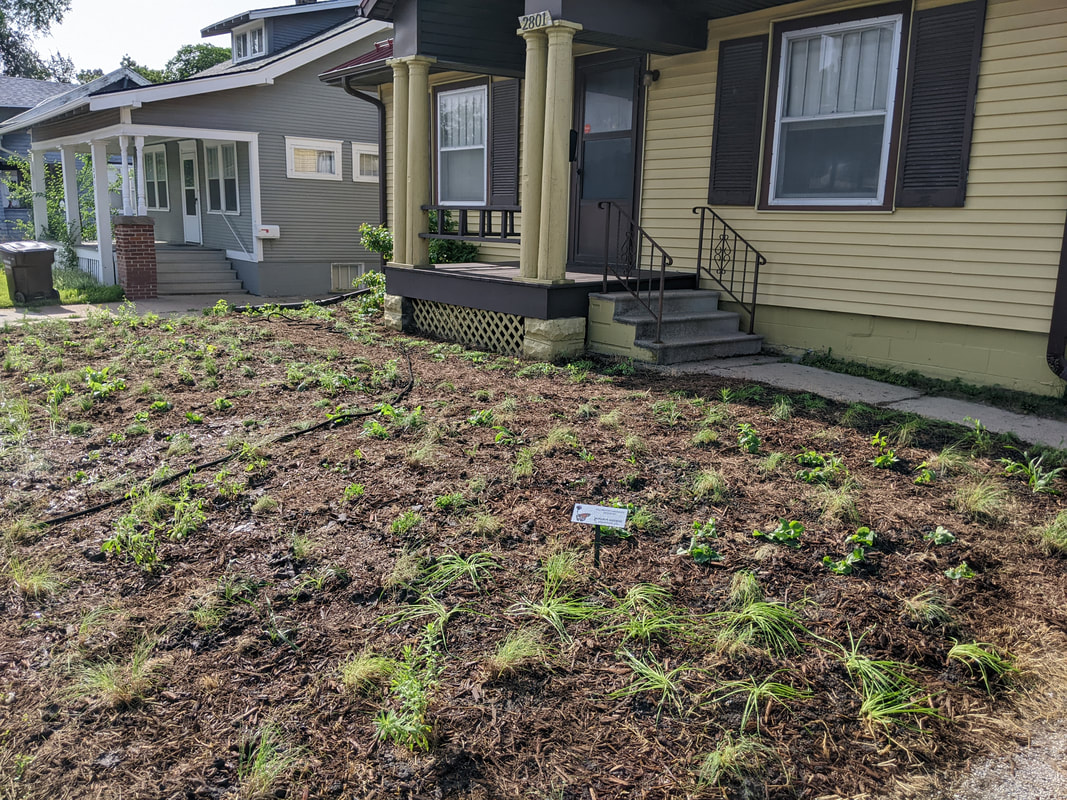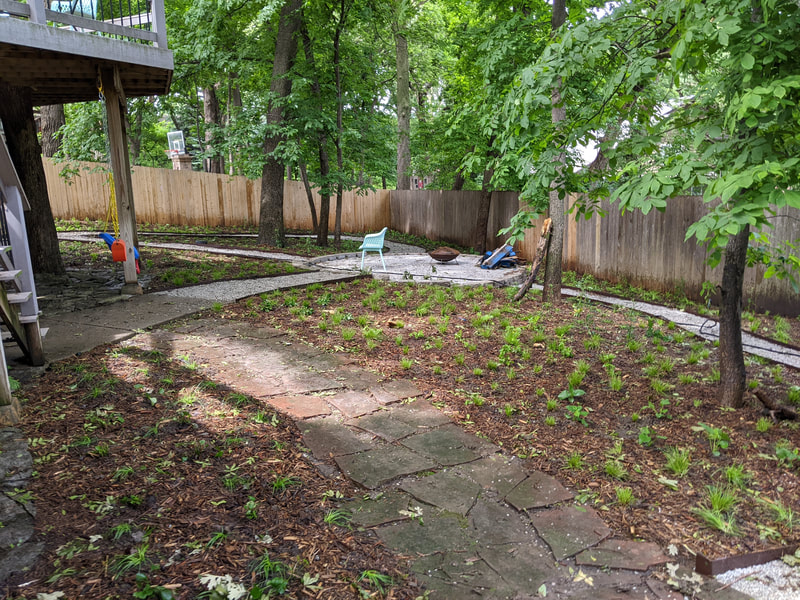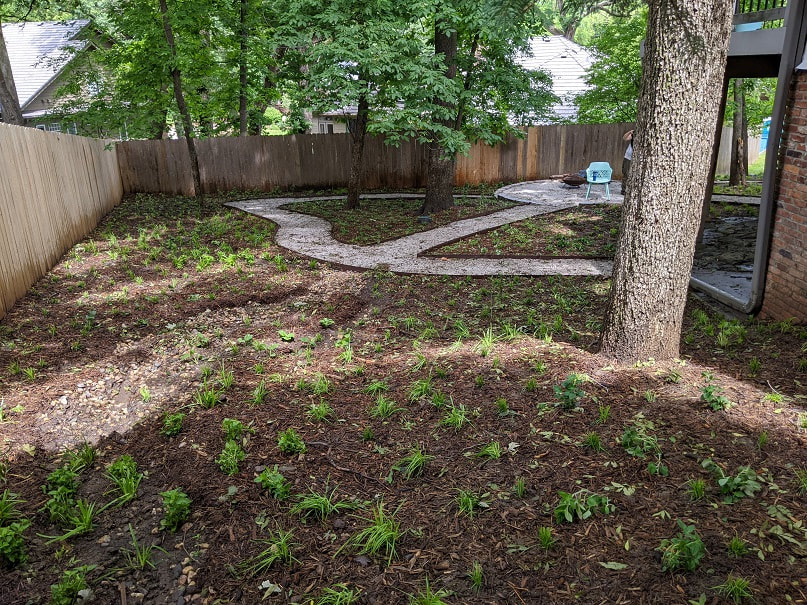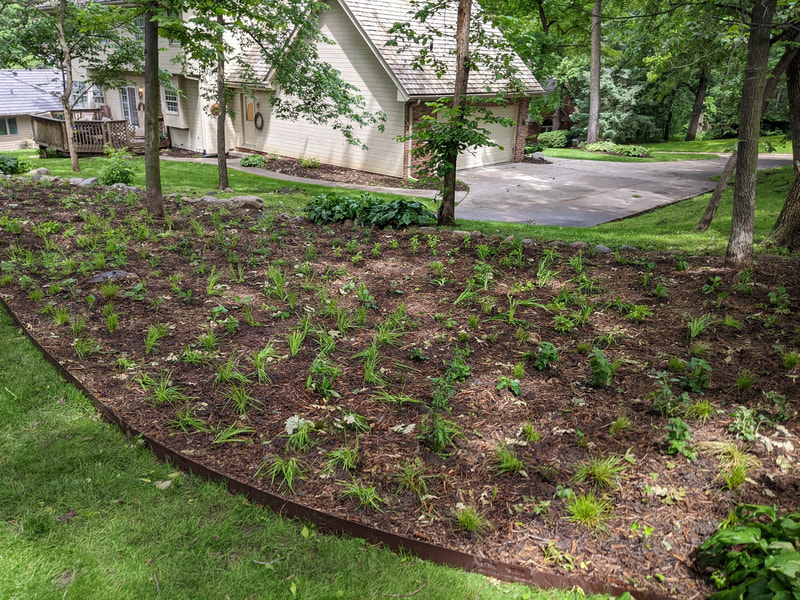So how can we select plants that work on site and with one another? Instead of taking the traditional gardening approach -- going to the nursery, reading plant tags, hoping -- it's time to look to wild plant communities, in person and in good books and websites. Research the plants. Put that time in, as it's like digging a good hole.
What grows together in the wild? How? If you want to make things a bit easier, use plants that grow side by side in the prairie or forest or desert. Or at the very least, grow in the same sort of environment (soil, light, drainage, competition, ecoregion) while matching their growth and reproductive habits. And of course, think about the niches plants will grow in and how to let them do their thing. Don't force it. Don't re-invent the wheel, especially at first.
Yesterday we planted a small front yard with these principles in mind. Of course, I'm a designer and I know a lot of plants at least moderately well, so I brought more things to the table -- plant and bloom succession, plant behavior, senescence and winter structure, controlling height so sight lines near driveways are clear, et cetera. But ultimately, I was selecting plants to work in various ways with one another, short term and long term. This is what I try to show you in my forthcoming book, and what I'll briefly highlight below plant by plant.
Bouteloua curtipendula (blue grama grass) -- Serves as the matrix. Gets only about 18-24" tall (that's mostly late summer seed heads).
Aquilegia canadensis (wild columbine) -- Short-lived perennial that will sow around in gaps and finger through the grasses.
Heuchera richardsonii (prairie alumroot) -- Large leaves shade the ground and remain through winter. Works well in drifts. Clumper.
Monarda bradburiana (bradbury's monarda) -- An ecoregion cheat because of it's shoulder-season blooms, shorter habit, and ability to fill in gaps.
Echinacea pallida (pale purple coneflower) -- Airy stalks reach 3' tall. Basal foliage stays low. Deep tap root goes below roots of other plants. Superb winter seed heads.
Rudbeckia hirta (black-eyes susan) -- Biennial provides early color and coverage, gently self sows, eventually fades away as perennials take over.
Asclepias tuberosa (butterflyweed) -- Slow-to-develop perennial that prefers to grow singly dotting the landscape. Deep taproot.
Callirhoe involucrata (poppy malow) -- Creeping groundcover with long bloom time, helps fill in low gaps and shade out weeds.
Coreopsis palmata (prairie coreopsis) -- Light runner will move between gaps, prefers less competition.
Liatris ligulistylis (meadow blazingstar) -- Tall but open stalks that push up through lower plants. Corms won't compete with fibrous roots of grasses or taprooted perennials.
Liatris punctata (dotted blazingstar) -- Shoulder-season bloomer with shorter stalks than LL, so works well with a short bunchgrass.
Conoclinium coelestinum (blue mistflower) -- A little patch by the downspout will bring early fall blooms to the space. Slowly spreads.
Symphyotrichum oblongifolium (aromatic aster) -- Dense, short, shrub-like perennial that provides late season pollen and nectar. Slowly spreads.
There are several things to notice from this list (which does not include the shade plants nearer the house):
1) There's decent bloom succession from April to October.
2) There are multiple plant species that share similar roles -- creepers, architectural, etc.
3) Root structure was considered to create the same sort of layers below ground as above ground.
4) There's a general uniformity of height at about 2 feet tall, which will help show intention and control.
5) While you can't see it in the image, plants were initially placed in masses and drifts IF the species grow this way in the wild. This also will help show intention. Over time, the plants will find their own way, and can be left to this exploration or lightly edited to help maintain some of the original layout.
6) There's an idea of plant succession. For example, Rudbeckia gives us early color and coverage (nice basal foliage in year one of new plants shades out weed seeds from germinating). Aquilegia will probably give way in time as other plants shade the ground (its seeds need light to germinate). And the Coreopsis might not last more than a few years as it doesn't like competition, but if it can find the gaps it will keep popping up in new spots, much like the Callirhoe and Monarda, and keep plugging holes for us.
There's not really an aggressive self sower in the bunch for these site conditions -- you likely wouldn't want that in a smaller area. And there are only a very species that might get aggressive with us on this dry, sunny spot: Coreopsis, Monarda, Callirhoe; if they get a bit too exuberant they ear easily edited. Most species here are clumpers, and the density of the site -- everything on about 12" centers -- will keep plants more honest and more in tune with how they may grow in the wild where competition is an asset (which is why a matrix of grass is so useful, plus it gives us a nice uniform base layer people love to see, hence lawns).
So there you go, a deeper dive into one of our many installs this spring season. I hope it's helped you think about gardening in some new ways. If you want to keep the ball rolling with more instruction and nuance, try the suite of 15 online classes.






 RSS Feed
RSS Feed

